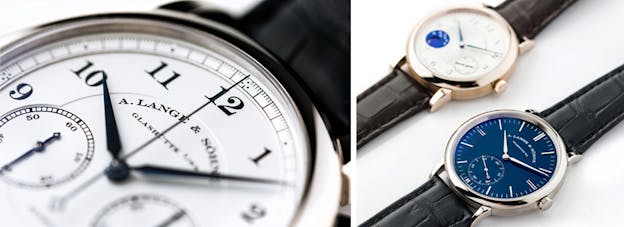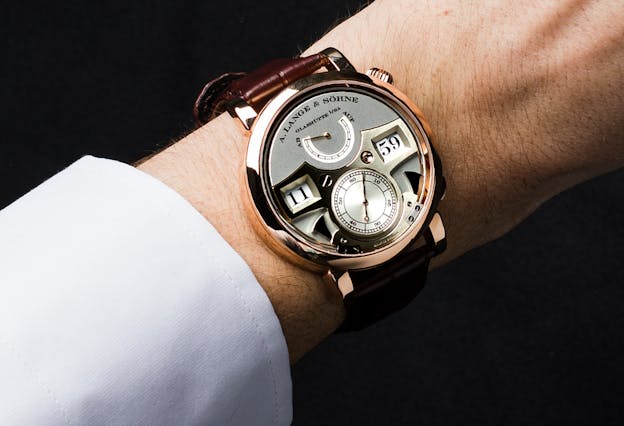Dr. Jekyll And Mr. Hyde: The Pendulum Swing of A. Lange & Söhne Watch Design
A. Lange & Söhne is by no means the only brand whose portfolio of watch collections is an expression of diversity, however when reflecting upon their watches, the connection between Lange’s design expressions and the Robert Louis Stevenson classic is all too fitting. On one end of the spectrum, Lange persistently draws from its heritage, and all of the classical elements that make Glashütte watchmaking distinct in the category. On the other end, and as sporadically as the brand sees fit, we are presented with bold, unabashed executions of contemporary design, albeit with the same traditionalist twist that makes every Lange cohesive. Though Dr. Jekyll and Mr. Hyde are two distinct characters, at the root they are one and the same if you examine them with a close lens. Lange’s more modern creations are by no means ‘evil’, but rather edgier and less constrained by their environment, history, or legacy.
Because the watches released at either end of the spectrum are equal in terms of overall quality, and often limited to fairly small production runs, Lange has managed to develop a devout collector following for both segments. It’s an interesting variation of the ‘something for everyone’ sort of approach, but not in the same broadening of catalog method often seen from larger luxury watch group brands. This is by no means the same as brands deciding that their portfolio needs to include a diver, a dress watch, a pilot, and so on, and so forth. Instead, it’s more of a matter of acknowledging that not all collectors (especially these days) are interested in dress watches, however there’s always an appreciation of traditional methods of finishing and movement design regardless of overall aesthetic. This appreciation is proven by the ever-growing appreciation for Patek and Kari Voutilainen on one end of the spectrum, and Richard Mille and MB&F on the other, as well as the fact that you’ll often see a Datograph or 1815 as part of a collection alongside the former, and a Zeitwerk alongside the latter. But how far apart are these creations, really?
Dr. Jekyll, I Presume?

With A. Lange & Sohne being so deeply rooted in history, it’s easy to see how its traditions trickle their way through the brunt of the brand’s collections. Even in nomenclature, this history rings through. The Saxonia collection is named after the former region of Saxony in which Glashütte resides, and the 1815 pays tribute to the year F.A. Lange was born. Each of these lines, as well as the Richard Lange collection are about as traditional as they come in terms of design. Either pad printed or applied indices, blued hands, and crisp cases most often crafted of precious metals—as one would expect from a brand holding firm to tradition. Where Lange gets a little sneaky here is in its complications, and not its aesthetics, by and large. After all, these are the collections that hide things like the Double and Triple Split, the Lange 31 (with a 31-day power reserve), and the Datograph Perpetual Tourbillon. Even with those heavy-hitting complications at hand, you’re still looking at conventional classics at the surface level; Not a button, cuff, or bowtie is even faintly out of place on the good doctor just yet.
Enter Mr. Hyde
The blazer has been unbuttoned, the sleeves rolled up, and somewhere in a corner on the floor of the Lange workshop rests an untied bowtie. Mr. Hyde has arrived, and he’s ready to party. From a corner of his eye we see the bright and radioactive glow of one of Lange’s heroes of contemporary design—the Lange Lumen collection.
Lange’s Director of Product Development, Anthony de Haas himself refers to the Lumen collection as a playground of sorts, allowing his creative team to step far outside the conventions of typical Lange dial design. Any self-respecting watch enthusiast out there can appreciate a thoughtful application of luminous material, and every watch to come out of this collection is exactly that. In the case of the 1815 Up/Down Chrono we are treated to a reverse ‘radioactive’ panda dial, complete with a lumed tachymeter scale, sundial ‘eyes’, and date discs, allowing for clear legibility in darkness. The Grand Lange 1 Moon Phase “Lumen,” on the other hand, delivers a glowing tapestry of night sky through its moonphase indication, alongside the requisite lumed hands and indices for time, date, and power reserve displays. Part of the beauty in these pieces isn’t just their glowing personalities either. Rather than a solid dial, Lange uses a smoked sapphire crystal which does a purposely modest job of masking the inner workings of the watch. When fully charged by UV light, the fully exposed indices are clear as day, yet a subtle glow still shows through the smoked disk, adding to the edgy display.

Of course, the story doesn’t stop with the Lumen, nor did it start there if we’re keeping count. The oddest, edgiest, most sought after contemporary has been and will always be the mighty Zeitwerk in all of its different forms. First launched in 2008, this was the first modern Lange with any sort of digital time indication, and the first modern wristwatch in existence with digital jumping hours and jumping minutes, linked to a constant escapement mechanism. From there the collection grew to include a Lumen variant, a date complication, and a string of chiming complications. One of the more interesting visual details of the Zeitwerk outside its time telling is actually quite functional—the frame surrounding its digital indications and seconds sundial is actually one of the bridges that supports the hour and minute discs.
Much as we can acknowledge the significant differences found between one end of Lange’s collections and the other, we also have to acknowledge the commonalities that make these pieces tick. What is that A. Lange & Söhne secret sauce, exactly? It’s said by many that even without hallmarks, you can spot a Lange in a second when looking through its display caseback, and I’d be pretty quick to agree with that statement. Quality plays a role in this, but more than anything it’s the execution of particular details that you won’t often see elsewhere.
The biggest and most obvious component is the three quarter plate—a manufacturing solution of F.A. Lange that dates clear back to 1864, and one that’s recognized as one of the biggest traditions in Glashütte watchmaking. More complex to execute during assembly, the intent was to create greater stability in pocket watch movements, and the design ethos has stuck through to the present day. You’ll also note the consistent use of German silver for said plates, blued screws (heat treated, not chemically treated), hand-engraved balance cocks, and lastly the use of gold chatons for most movement jewels. Now, none of these elements are exclusive to Lange alone, but it’s the complete package and its flawless execution that keeps Lange ahead of the pack.

When the Datograph was introduced in 1999, it reset the standard for the chronograph, making the world pay attention to high-end, in-house chronograph movements. At that point, the most elite brands were using Lemania-based movements, decorating and assembling them, but not investing in the technology to build from the bottom up. And then this brand from Germany introduced a gorgeous chronograph, which lit a fire for the Swiss industry.
While rather conservative from its dial side, as soon as you flip the Datograph over, you know this watch was built to be viewed from the back. The movement was designed by Annegret Fleischer, features outstanding three-dimensionality, and is immaculately finished.





